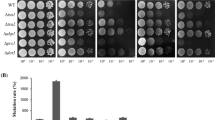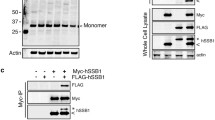Abstract
Reactive oxygen species are a by-product of aerobic metabolism that can damage lipid, proteins, and nucleic acids. Oxidative damage to DNA is especially critical, because it can lead to cell death or mutagenesis. Previously we reported that the yeast sub1 deletion mutant is sensitive to hydrogen peroxide treatment and that the human SUB1 can complement the sensitivity of the yeast sub1 mutant. In this study, we find that Sub1 protects DNA from oxidative damage in vivo and in vitro. We demonstrate that transcription of SUB1 mRNA is induced by oxidative stress and that the sub1Δ mutant has an increased number of chromosomal DNA strand breaks after peroxide treatment. We further demonstrate that purified Sub1 protein can protect DNA from oxidative damage in vitro, using the metal ion catalyzed oxidation assay.




Similar content being viewed by others
References
Haber JE (2002) Uses and abuses of HO endonuclease. Methods Enzymol 350:141–164
Duracková Z (2010) Some current insights into oxidative stress. Physiol Res 59:459–469
Valko M, Rhodes CJ, Moncol J et al (2006) Free radicals, metals and antioxidants in oxidative stress-induced cancer. Chem Biol Interact 160:1–40. doi:10.1016/j.cbi.2005.12.009
Yu L, Croze E, Yamaguchi KD et al (2015) Induction of a unique isoform of the NCOA7 oxidation resistance gene by interferon β-1b. J Interferon Cytokine Res 35:186–199. doi:10.1089/jir.2014.0115
Go Y-M, Jones DP (2010) Redox control systems in the nucleus: mechanisms and functions. Antioxid Redox Signal 13:489–509. doi:10.1089/ars.2009.3021
Slupphaug G, Kavli B, Krokan HE (2003) The interacting pathways for prevention and repair of oxidative DNA damage. Mutat Res 531:231–251
Lukosz M, Jakob S, Büchner N et al (2010) Nuclear redox signaling. Antioxid Redox Signal 12:713–742. doi:10.1089/ars.2009.2609
Kretzschmar M, Kaiser K, Lottspeich F, Meisterernst M (1994) A novel mediator of class II gene transcription with homology to viral immediate-early transcriptional regulators. Cell 78:525–534
Kaiser K, Stelzer G, Meisterernst M (1995) The coactivator p15 (PC4) initiates transcriptional activation during TFIIA-TFIID-promoter complex formation. EMBO J 14:3520–3527
Werten S, Langen FW, van Schaik R et al (1998) High-affinity DNA binding by the C-terminal domain of the transcriptional coactivator PC4 requires simultaneous interaction with two opposing unpaired strands and results in helix destabilization. J Mol Biol 276:367–377. doi:10.1006/jmbi.1997.1534
Wang J-Y, Sarker AH, Cooper PK, Volkert MR (2004) The single-strand DNA binding activity of human PC4 prevents mutagenesis and killing by oxidative DNA damage. Mol Cell Biol 24:6084–6093. doi:10.1128/MCB.24.13.6084-6093.2004
Henry NL, Bushnell DA, Kornberg RD (1996) A yeast transcriptional stimulatory protein similar to human PC4. J Biol Chem 271:21842–21847
Knaus R, Pollock R, Guarente L (1996) Yeast SUB1 is a suppressor of TFIIB mutations and has homology to the human co-activator PC4. EMBO J 15:1933–1940
Kim IH, Kim K, Rhee SG (1989) Induction of an antioxidant protein of Saccharomyces cerevisiae by O2, Fe3+, or 2-mercaptoethanol. Proc Natl Acad Sci USA 86:6018–6022
Salmon TB, Evert BA, Song B, Doetsch PW (2004) Biological consequences of oxidative stress-induced DNA damage in Saccharomyces cerevisiae. Nucleic Acids Res 32:3712–3723. doi:10.1093/nar/gkh696
Imlay JA, Linn S (1988) DNA damage and oxygen radical toxicity. Science 240:1302–1309
Azevedo F, Marques F, Fokt H et al (2011) Measuring oxidative DNA damage and DNA repair using the yeast comet assay. Yeast 28:55–61. doi:10.1002/yea.1820
Ge H, Martinez E, Chiang CM, Roeder RG (1996) Activator-dependent transcription by mammalian RNA polymerase II: in vitro reconstitution with general transcription factors and cofactors. Methods Enzymol 274:57–71
Park JW, Floyd RA (1994) Generation of strand breaks and formation of 8-hydroxy-2′-deoxyguanosine in DNA by a Thiol/Fe3+/O2-catalyzed oxidation system. Arch Biochem Biophys 312:285–291. doi:10.1006/abbi.1994.1311
Werten S, Stelzer G, Goppelt A et al (1998) Interaction of PC4 with melted DNA inhibits transcription. EMBO J 17:5103–5111. doi:10.1093/emboj/17.17.5103
Mortusewicz O, Roth W, Li N et al (2008) Recruitment of RNA polymerase II cofactor PC4 to DNA damage sites. J Cell Biol 183:769–776. doi:10.1083/jcb.200808097
Batta K, Yokokawa M, Takeyasu K, Kundu TK (2009) Human transcriptional coactivator PC4 stimulates DNA end joining and activates DSB repair activity. J Mol Biol 385:788–799. doi:10.1016/j.jmb.2008.11.008
Yu L, Volkert MR (2013) Differential requirement for SUB1 in chromosomal and plasmid double-strand DNA break repair. PLoS ONE 8:e58015. doi:10.1371/journal.pone.0058015
Pan ZQ, Ge H, Amin AA, Hurwitz J (1996) Transcription-positive cofactor 4 forms complexes with HSSB (RPA) on single-stranded DNA and influences HSSB-dependent enzymatic synthesis of simian virus 40 DNA. J Biol Chem 271:22111–22116
Mortusewicz O, Evers B, Helleday T (2015) PC4 promotes genome stability and DNA repair through binding of ssDNA at DNA damage sites. Oncogene. doi:10.1038/onc.2015.135
Calhoun LN, Kwon YM (2011) Structure, function and regulation of the DNA-binding protein Dps and its role in acid and oxidative stress resistance in Escherichia coli: a review. J Appl Microbiol 110:375–386. doi:10.1111/j.1365-2672.2010.04890.x
Zhao G, Ceci P, Ilari A et al (2002) Iron and hydrogen peroxide detoxification properties of DNA-binding protein from starved cells. A ferritin-like DNA-binding protein of Escherichia coli. J Biol Chem 277:27689–27696. doi:10.1074/jbc.M202094200
Werten S, Moras D (2006) A global transcription cofactor bound to juxtaposed strands of unwound DNA. Nat Struct Mol Biol 13:181–182. doi:10.1038/nsmb1044
Kannan P, Tainsky MA (1999) Coactivator PC4 mediates AP-2 transcriptional activity and suppresses ras-induced transformation dependent on AP-2 transcriptional interference. Mol Cell Biol 19:899–908
Baudin A, Ozier-Kalogeropoulos O, Denouel A et al (1993) A simple and efficient method for direct gene deletion in Saccharomyces cerevisiae. Nucleic Acids Res 21:3329–3330
Adams A, Gottschling DE, Kaiser CA, Stearns T (1997) Methods in yeast genetics. Cold Spring Harbor Press, New York, p 178
He F, Jacobson A (1995) Identification of a novel component of the nonsense-mediated mRNA decay pathway by use of an interacting protein screen. Genes Dev 9:437–454
Yu L, Volkert MR (2013) UV damage regulates alternative polyadenylation of the RPB2 gene in yeast. Nucleic Acids Res 41:3104–3114. doi:10.1093/nar/gkt020
Yu L, Volkert MR (2013) UV damage regulates alternative polyadenylation of the RPB2 gene in yeast. Nucleic Acids Res 41:3104–3114. doi:10.1093/nar/gkt020
Herschleb J, Ananiev G, Schwartz DC (2007) Pulsed-field gel electrophoresis. Nat Protoc 2:677–684. doi:10.1038/nprot.2007.94
Acknowledgments
We thank Michael Hampsey, James Haber, and Johannes Hegemann for yeast strains and plasmids, Kenan Murphy and Jen-Yeu Wang for strain construction and Martin Marinus, Anita Fenton, Feng He, Yahui Kong, and Hang Cui for technical advice and assistance. This work was funded in part by NIH grant CA100122.
Author information
Authors and Affiliations
Corresponding author
Rights and permissions
About this article
Cite this article
Yu, L., Ma, H., Ji, X. et al. The Sub1 nuclear protein protects DNA from oxidative damage. Mol Cell Biochem 412, 165–171 (2016). https://doi.org/10.1007/s11010-015-2621-x
Received:
Accepted:
Published:
Issue Date:
DOI: https://doi.org/10.1007/s11010-015-2621-x




